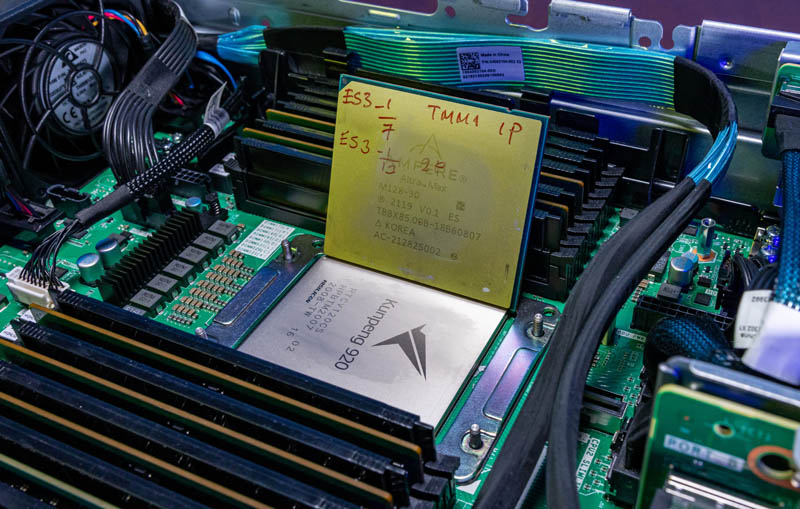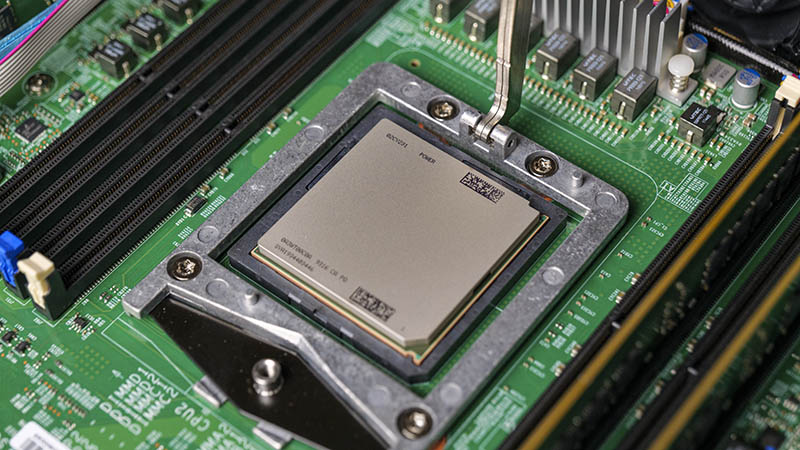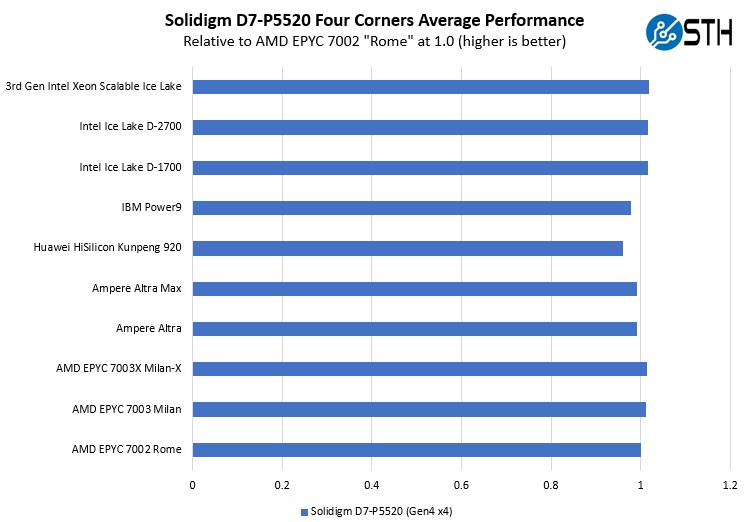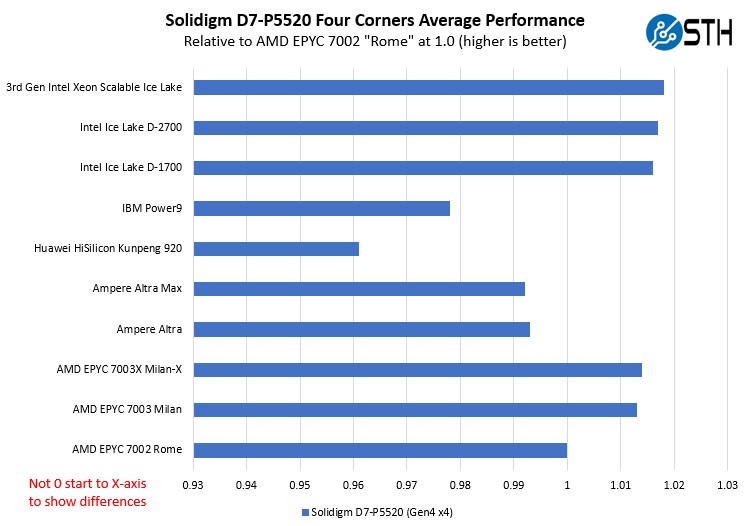Solidigm D7-P5520 7.68TB Performance by CPU Architecture
If you saw our recent More Cores More Better AMD Arm and Intel Server CPUs in 2022-2023 piece, you may have seen this photo. This is a 128 core Ampere Altra Max Arm CPU (lit by a yellow spotlight) next to a Huawei / HiSilicon Kunpeng 920 48-core Arm processor. One cannot buy the Kunpeng 920 in the US, nor the dual CPU server it is in (the Huawei TaiShan 200), but we managed to get one. This is in addition to the Ampere Altra 80 core CPUs that are from the family used by Oracle Cloud, Microsoft Azure, and Google Cloud. We could not get the AWS Graviton2/ Graviton3 to test with, but if there is a way, we will hopefully get one one day.

The other one that many may not have seen on STH previously is that we actually have several IBM Power9 LC921 servers in the lab. We were able to use the PCIe Gen4 slots, (albeit not with hot-swap bays) to get connectivity for the drives. On a relative scale, Ampere Arm was easy, Huawei/ HiSilicon was more challenging (our first tests were ~80% of AMD EPYC performance), but the IBM Power9 servers have taken a lot more time to get working for this. We may do a review of the LC921 just for YouTube later this quarter just for fun.

With that, we also had AMD EPYC 7002 “Rome”, EPYC 7003 “Milan”, EPYC 7003X “Milan-X, 3rd Generation Intel Xeon Scalable (Ice Lake), and the new Ice Lake-D 2700 using the Supermicro platforms from our Welcome to the Intel Ice Lake D Era with the Xeon D-2700 and D-1700 series. Here are the ten PCIe Gen4-based CPU architectures we could test the drives with using the AMD EPYC 7002 “Rome” as the base case. We used our four corners numbers and then averaged the percentage deltas from the Rome results:

Since we now are within a 6% relative performance range, here is the non-zero X-axis chart zooming in on the results:

Again, a disclaimer, the above is zoomed in and a non-zero X-axis version of the chart above. We were fairly close on these results.
Being a bit fair here, the Huawei HiSilicon Kunpeng 920 is the newest platform in our lab but we now are getting ballpark results that we would expect from that PCIe Gen4 platform after taking into account the non-standard NUMA architecture that we see on the CPUs. Intel’s PCIe Gen4 controllers are great and we get perhaps very weak scaling with memory and frequency. Still, we can see the Ampere parts in an almost even heat with the AMD EPYC 7002 “Rome” and the Milan-based parts slightly ahead.
Perhaps the best part is that despite these drives still carrying the “Intel” branding, we got them working reasonably well on many non-Intel architectures. Really only the IBM Power9 and the Kunpeng 920 were off by more than a +/- 2% margin that most folks do not care about.
For those wondering where the Cooper Lake 3rd Generation Intel Xeon Scalable, Xeon D-2700, D-1500/ D-1600, Cascade Lake, AMD EPYC 7001 “Naples” results, and so forth are, since we now have ten PCIe Gen4 platforms, we decided to just limit testing to PCIe Gen4 platforms and not include PCIe Gen3 platforms.
Final Words
Overall, the Solidigm D7-P5520 is a nice NVMe SSD. This drive really shows a lot of the hallmark features that we had come to expect of Intel’s NVMe line. Namely, the focus on low queue depth performance and a lot of the reliability features that made Intel drives the gold standard for generations. We saw great performance both in our synthetic and real-world application testing.

To us, perhaps the biggest item we would want to see changed is the swap to the Solidigm label. That branding swap needs to happen, and it will. We are rapidly approaching the PCIe Gen5 generation of SSDs as those platforms are launched over the next few quarters. Hopefully, that will be the inflection point for Solidigm’s branding.
Still, we delayed this review just to get to test with a bunch of different architectures in what may be the first SSD review to utilize ten different PCIe Gen4 CPU platforms. It was great to see compatibility beyond just x86 here.




That’s so cool even Power and Kunpeng!
I was this many days old when I saw a SSD review with three different ARM, AMD, and Intel CPUs and an IBM one. I’d say that’s the biggest finding of this review. It’s probably the first time I’ve ever seen a PCIe or NVMe device tested on that many types of CPUs and their PCIe roots.
Well now, that’s a different way to look at SSDs. It’s relevant tho because everything isn’t just Intel now. Gotta love STH for doin’ this.
The POWER9’s difficulties at PCIe Gen 4 speeds likely originates as it was the first PCIe Gen 4 capable host to hit the server market. Most vendors didn’t start validating Gen 4 speeds until Rome arrived years later.